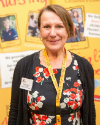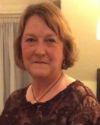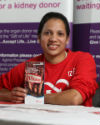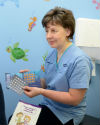Case studies demonstrating the value of nursing
The RCN is committed to demonstrating the value of nursing and building the capacity and capability of nurses to apply the principles of economic assessment in practice.
Demonstrating Value
The RCN Demonstrating Value programme equips frontline staff with the skills, tools, and techniques to secure commitment for their service and support for ongoing development. Chose between the one-day masterclass or commission a full programme.

An economic assessment of the child and family service at St Columba's Hospice
Donna Hastings
Family Support Team Worker, St Columba's Hospice
Donna's case study was completed in 2020 and reflects 2020 prices
According to the Childhood Bereavement Network in 2014, 41,000 children were bereaved of a parent or primary care giver in the UK. Longitudinal studies show that children who are bereaved are less likely to thrive, and are less likely to reach their academic potential and do well in exams; they are less likely to have secure attached relationships later in life, and they are more likely to offend.
The Child and Family Support Service at St Columba's Hospice was established in December 2018, in recognition that there was a lack of pre- and post-bereavement support in relation to children and young people within a family. St Columba's Hospice has 340,000 people living within its catchment, with an estimate of 215 children who are bereaved each year as a result of a terminal illness, and the hospice wanted an innovative way of targeting these children and providing holistic family support.
Donna's economic assessment, based on a Cost Avoidance Approach (CAA) which looks at avoided spend (not necessarily a decreased spend), was designed to demonstrate the impact and value of the Child and Family Service. This involved both the provision of a service in the hospice and also outreach into the community, with a specific focus on schools. This service is directed towards the hospice population with the aim of mitigating a range of potential short, medium and long-term negative outcomes through providing early intervention.
Case studies are used to illustrate the short-term impacts of the service to date, followed by a discussion of the medium and long-term impacts of bereavement, which the service aims to mitigate.
The economic assessment illustrated the potential for the service to contribute to the avoidance of negative outcomes in approximately 125 children and young people year on year. As the service develops there is potential for further work to quantify the impact of the service in the medium to long term and monetise the potential costs avoided as a result.
You can contact Donna by email DHastings@stcolumbashospice.org.uk

An economic assessment of making Occupational Therapy Services more therapeutically led
Lynsey Cameron
Senior Occupational Therapist, Ayrshire Hospice
Lynsey's case study was completed in 2019 and reflects 2019 prices
Occupational Therapist's (OTs) look at the barriers to engagement in daily activities. It is widely recognised that in palliative care, patients will functionally decline and with that comes significant losses in participation in day to day activities; roles; decision making and quality of life. However, it has been shown that participation in meaningful activities improves symptoms such as fatigue; pain and anxiety; allows patients to adapt and learn new strategies to maintain their independence; and also allows them to regain some control and enhance their quality of life despite their reduced ability in function. (Mills and Payne, 2014)
Aware of the potential of participation in meaningful activities, Lynsey, a senior Occupational Therapist at Ayrshire hospice introduced practical group sessions to promote self-management in the hospice day services centre. In addition, Lynsey increased awareness of the role of occupational therapy in palliative care, and increased the confidence of the staff to refer to the service. She also improved the efficiency of the occupational therapy service.
Lynsey demonstrated that with little set up or running costs and simply through service redesign, specialist palliative care OTs can increase the number of patients referred to their service. As well as demonstrating improvements in patients' perceptions of their and their carer's anxiety, Lynsey also highlighted the potential of her re-designed service to address practical issues and avoid costs elsewhere in the system. Examples included the avoidance of referrals to local authority OT services, the hospice counselling service and the hospice Respite and Response team.
You can contact Lynsey by email: Lynsey.cameron@ayrshirehospice.org.

Enhancing the day therapies service for people with palliative neurological conditions: an economic evaluation
Yvonne Whitehouse
Day Therapies Manager, St Columba's Hospice
Yvonne's case study was completed in 2019 and reflects 2019 prices
Government policy in Scotland is to increase access to palliative and end of life care for all who can benefit from it. This includes people with progressive neuromuscular degenerative illnesses (such as Motor Neurone Disease [MND], Progressive Supranuclear Palsy [PSP], Multi-systems Atrophy [MSA] and Corticobasal Degeneration [CBD]) who have a high level of physical impairment and need full assistance with personal care, moving their limbs, eating, drinking and communicating.
Yvonne, Day Therapies Manager at St Columba's Hospice in Edinburgh, recognised that her current day therapies service model did not optimally support the needs of these patients. Therefore she proposed introducing an additional day ('assisted day') designed specifically to address their needs. Her economic assessment identifies the full costs of her service innovation. By bringing services to the hospice and tailoring these to each individual patient's needs, Yvonne identifies the benefits for patients, their families and the NHS, as well as the Hospice.
By engaging with stakeholders and enabling them to work differently, investing in volunteers and redeploying hospice staff, Yvonne has shown the difference that can be made with a modest investment.
You can contact Yvonne by email: ywhitehouse@stcolumbashospice.org.uk.

An economic evaluation of community services at St. Vincent’s Hospice
Brona McGee and Dr Mairi-Clare McGowan
Director of Care and Consultant in Palliative Medicine, St. Vincent's Hospice
Brona and Mairi-Clare's case study was completed in 2019 and reflects 2019 prices
In order to ensure their services were addressing current need and in line with national policy, St Vincent's hospice in Howwood, Renfrewshire, commissioned a review of their community services. Six recommendations were proposed.
After exploring what a more integrated service might look like, Brona McGee, Director of Care and Mairi-Clare McGowan, Consultant in Palliative Medicine, St Vincent's Hospice, Howwood elected to focus their attention on two of the review recommendations. They developed proposals for service redesign in two distinct areas of their community services and applied the principles of economic assessment in each case. Whilst working as a team each took the lead in a specific area.
Brona focused on their bereavement /counselling service and using a cost-effectiveness approach compared the current one-to-one counselling service with a proposed hybrid approach incorporating both group support and one-to-one counselling options. Based on the assumption that the outcomes would be similar in each case and that the number of people accessing the service would remain the same, Brona demonstrated that her proposed service redesign was a more cost effective approach.
Mairi-Clare focused on the clinical nurse specialist community outreach service which currently provide specialist support and advice to patients and families affected by life-limiting conditions during normal working hours, Monday-Friday. The service-redesign and development proposed would maintain the benefits of the current service, extend its reach beyond those affected by cancer and further develop the range of support available to include hands-on practical support and carer respite a 7-days a week.
These ambitious plans would require investment so Mairi-Clare developed a costs consequence analysis and offered a range of options as to how these costs might be met.
You can contact Brona and Mairi-Clare by email: Brona.McGee@svh.co.uk and Mairi-Clare.McGowan@svh.co.uk.

Economic evaluation to inform the redesign of a specialist palliative care nursing service
Margaret Cassidy
Community and Day Services Manager, Ayrshire Hospice
Margaret's case study was completed in 2019 and reflects 2019 prices
In 2018, the Ayrshire Hospice commissioned a clinical service review which surfaced requests for greater out-of-hours accessibility of services in the community. In concluding that a seven-day community specialist palliative care nurse service could go some way towards addressing this perceived unmet need, Margaret Cassidy, Community and Day Services Manager, undertook an economic assessment of her proposed service redesign.
In this economic assessment Margaret sets out the costs and benefits of providing a seven-day service through the redeployment of the establishment currently deployed over five days. The potential positive and negative outcomes of the proposed service re-design were systematically validated through stakeholder engagement and benchmarking with another hospice.
The additional costs of service provision over weekends and bank holidays are presented as a consequence analysis. The potential benefits, including opportunities for cost that may be avoided elsewhere in the system, are identified.
Case studies reported by the respite and response team are used to illustrate where community specialist palliative care nurse availability could ensure a more timely response to patients' and families' immediate care and support needs, as well as increase the continuity and consistency of care. They also highlight the potential for the service to reduce the burden of care on out-of-hours services and prevent avoidable hospital admissions.
A systematic audit of calls taken by the hospice in-patient unit charge nurse over weekends demonstrates the potential to "release capacity to care" here too. A summary of indicative costs that may be avoided is presented and set against the costs of service redesign.
You can contact Margaret by email via Margaret Wilkie, Patient Services Director, margaret.wilkie@ayrshirehospice.org.

Nurse education: valuing the contribution of people with a learning disability
Ruth Wyn Williams
Lecturer in Healthcare Sciences (Learning Disability), Bangor University
Ruth's case study was completed in 2019 and reflects 2019 prices
Ruth Wyn Williams argues that as a learning disability nurse working within a Higher Education Institute (HEI), she has a responsibility to ensure that the future nursing workforce is fit for purpose with the skills and knowledge to work in partnership with some of the most vulnerable individuals in society. Ruth sets out the policy imperatives for taking an interactive approach in her teaching and drawing on the expertise of people with learning disabilities and their families.
To illustrate the value of her interactive teaching methods, Ruth used a cost consequence approach to surface the additional costs incurred with a cohort of 3rd year undergraduate adult nursing students when compared with traditional didactic teaching methods. Ruth also set out the range of benefits which are potentially attributable, in part, to her intervention. Benefits not only for her students, but also those contributors with a learning disability, her HEI colleagues and the HEI itself.
By applying Kirkpatrick's evaluation framework, Ruth illustrates the positive reaction of her students to the approach taken and captures evidence of their learning. Ruth also gives consideration to the longer term impact of this learning on the behaviours of these students in their practice.
You can contact Ruth by email: r.w.williams@bangor.ac.uk.

An Economic Assessment to evaluate the Bradford telemedicine service provided by the Metabolic Medicine team at Salford Royal Hospital
Briony McNelly
Learning Disability Liaison Nurse, Northern Care Alliance NHS Group
Briony's case study was completed in 2018 and reflects 2018 prices
Briony McNelly has applied the principles of economic assessment to evaluate a specialist metabolic telemedicine service providing care closer to home for patients with inherited metabolic disorders. Briony shows the set up and running costs of the current nurse/AHP-led outreach telemedicine service with the Consultant linking in from Salford and considers the costs and benefits of this service when compared to a Consultant-led out-reach clinic. Presenting the tariff income as a benefit, Briony demonstrates that the telemedicine service is a considerably more efficient means of providing the service.
Briony then considers the potential costs and benefits of enhancing the roles and responsibilities of the nursing/AHP personnel providing the out-reach clinic and demonstrates the value of the model proposed.
Finally Briony illustrates the potential for increasing capacity to meet the rising demand for the service by demonstrating the costs and benefits of providing two outreach clinics per day instead of one (as currently provided).
You can contact Briony by email: briony.mcnelly@pat.nhs.uk.

Economic evaluation of the role of the non-medical Approved Clinician
Delia Wainwright
General Manager, Devon Partnership NHS Trust
Delia’s case study was completed in 2018 and reflects 2018 prices
Delia Wainwright demonstrated the value of developing the role of a non-medical approved clinician for an inpatient learning disability service. Delia set out the policy drivers and local context for this role development and has shown that her proposal is both safe and cost effective. She argues that evidence shows there is no risk to quality or service delivery.
Delia concludes that when fully implemented a non-medical approved clinician has the potential to release recurrent financial savings of £34,102.68 per annum. Compared to an agency locum Consultant Psychiatrist, a non-medical approved clinician is shown to be £101,506.68 per annum more cost efficient.
You can contact Delia by email: delia.wainwright@nhs.net.

Demonstrating the value of an acute Learning Disabilities liaison service within Hywel Dda University Health Board
Linda Phillips
Community Learning Disability Nurse, Hywel Dda University Health Board
Linda's case study was completed in 2018 and reflects 2018 prices
Linda Phillips has shown how she and her colleagues will demonstrate the true value of a new Acute Learning Disability Liaison Service. In her report Linda sets out the policy drivers and local context for this service development. She details the full economic set up and running costs of the service as £80,700.45 in year one and £80,554.19 in year two.
Linda sets out a wide range of qualitative and quantitative benefits, some of which she has monetised. For example, Linda shows that by enabling a reduction in the length of hospital stay, costs are avoided. If the length of stay for 39% of patients with a learning disability is reduced by one day, £50,255.23 per year of costs would be avoided. However following peer review it was agreed reasonable to assume that approximately a third of patients admitted will have complex needs. Based on a current patient case study, Linda estimates potential cost avoidance could be between £582,689.25 and £791,859.75 per year. Furthermore, reduced length of stay will free up capacity and contribute to Welsh Government targets for A&E and referral to treatment times.
You can contact Linda by email: linda.phillips@wales.nhs.uk.

An economic assessment of the children's epilepsy nurse specialist role
Kirsten Johnson
Roald Dahl Sapphire Epilepsy Nurse Specialist, Sherwood Forest Hospitals NHS Trust
Kirsten's case study was completed in 2017 and reflects 2017 prices
Epilepsy in children can be distressing for children and for their parents therefore NICE recommend that children, young people and their families have access to specialist nursing support. The ability to contact a specialist nurse at the point of need improves the management of the condition and service user's satisfaction; it can significantly improve the well-being of the child, reduce parental stress and avoid the use of other parts of the healthcare system, including acute services.
However prior to Kirsten's economic assessment, little was known of the economic benefits of a CNS-led service other than these quality benefits. Kirsten is a Roald Dahl Sapphire Epilepsy Nurse Specialist at Sherwood Forest Hospitals NHS Trust.
Through rigorous analysis of her records, Kirsten has demonstrated that just one aspect of her service, that is her telephone and advice line service, has avoided £84,778 costs in her trust in just one year. This aspect of her service has contributed to her trust meeting its 18 week waiting time target and her analysis has clearly demonstrated why this aspect of her service, which has hitherto been invisible, should be incorporated into the service tariff to increase her trust's income and enable further service development.
You can contact Kirsten by email: Kirsten.johnson4@nhs.net.

An economic assessment of the Roald Dahl sapphire paediatric epilepsy nurse specialist service
Hannah Chaffe
Roald Dahl Sapphire Paediatric Epilepsy Nurse Specialist, Ashford and St Peter's NHS Foundation Trust
Hannah's case study was undertaken in 2017 and reflects 2017 prices
One in 100 of the population in the United Kingdom are affected by epilepsy, a chronic illness which impacts on a person's emotional, physical, mental and social wellbeing. NICE recommends that children and young people with epilepsy should have access to an epilepsy specialist nurse.
Hannah, a Roald Dahl Sapphire Epilepsy Nurse Specialist at Ashford and St Peter's NHS Foundation Trust, supports children and young people with epilepsy and their families by helping them to be better equipped to manage their seizures. She supports the families by being the first point of contact for them, supporting them in the community by making home visits and training staff at schools and nurseries and providing care plans for each child. To demonstrate the value of her service, Hannah used a cost avoidance approach. She stratified her caseload using criteria she developed and ratified through peer review. She then examined 'typical' high dependency cases, applied a sensitivity analysis and predicted potential costs avoided. Hannah's predictions were then subjected to multidisciplinary peer review and Hannah concluded that her service may avoid between £23,210 - £65,296 per annum, when working with those with the greatest need at any one time. She plans to do further work to explore the impact of her service on those patients and families in the medium and low dependency categories.
You can contact Hannah by email Hannah.chaffe@nhs.net.

An economic assessment of a nurse-led Transcranial Doppler (TCD) service
Edith Aimiuwu
Roald Dahl Paediatric Haemoglobinopathy Clinical Nurse Specialist, Whittington Health NHS Trust
Edith's case study was completed in 2017 and reflects 2017 prices
Edith's case study was completed in 2017 and reflects 2017 prices
Sickle cell disease is a recessive blood disorder caused by a mutation in the B- globin gene. Stroke is recognised as a major complication of sickle cell disease and the risk of stroke is estimated to be 250 times higher in those with sickle cell disease compared with the general population.
Annual Transcranial Doppler Scanning (TDS) is recommended for early identification of stroke risk factors in children with sickle cell disease between the ages of 2 and 16 years old. This enables referral on to other services for further investigations and early intervention with blood transfusion and medication management where indicated.
Hitherto, as far as we know, TDS has only been undertaken by senior medical staff trained in the use of the specialist equipment, for example the EZ-Dop mobile non-imaging scanning device. However Edith, Roald Dahl Paediatric Haemoglobinopathy Nurse Specialist at Whittington Health NHS Trust, has established a nurse-led TDS service and sought to demonstrate the value of her nurse-led service.
Arguing that the outcomes are identical for a nurse-led and a consultant-led service, Edith demonstrated that a nurse-led service is as effective, more efficient and offers enhanced continuity of care.
Edith has been a Roald Dahl Nurse for 13 years, firstly at North Middlesex University Hospital NHS Trust and then at Whittington Health NHS Trust since 2006. She works with children and young people (aged from 3 months to 18 years) with Sickle Cell Disease and Thalassaemia, both inherited blood disorders.
As a Roald Dahl Nurse, Edith acts as a named nurse and is a point of contact for the patients and families. She co-ordinates care by liaising with internal and external agencies. Her work is not confined to the hospital, as she works in the community supporting her patients at their schools by writing up the child's care plans, giving health advice and educating the teaching staff and pupils. She has a supportive and educational role assisting the child to manage their own condition and identify signs and symptoms that need prompt medical attention. Edith also smooths the pathway for patients within the hospital.
You can contact Edith by email: edith.aimiuwu@nhs.net.

An economic assessment of the paediatric epilepsy nurse service within a district general hospital
Natalie Baines
Roald Dahl Sapphire Epilepsy Nurse Specialist, Royal Surrey County Hospital NHS Foundation Trust
Natalie's case study was undertaken in 2017 and reflects 2017 prices
Approximately 50 million people worldwide (WHO, 2016), and about 600,000 in the UK are effected by epilepsy (Epilepsy Action, 2016). Epilepsies are a common childhood neurological disorder giving rise to recurrent seizures. Three in 1000 children with a diagnosis of epilepsy, aged 17 years or younger, take anti-epileptic medication to control their seizures (NICE, 2012). Managing seizures improves health outcomes and can help to minimise any detrimental impact on social, educational and employment activity (NICE, 2012). However epilepsy is not a static condition and children and families can struggle with the high level of uncertainty and unpredictability regarding 'when the next seizure' is going to occur. This also created a challenge for Natalie, when demonstrating the value of her CNS-led service.
Natalie, a Roald Dahl Sapphire Epilepsy Nurse Specialist at Royal Surrey County Hospital NHS Foundation Trust, identified approximately 170 children and young people on her caseload. To better understand her workload at any one time, she developed a patient classification system which she validated though peer review. This allowed her to stratify her caseload into three categories of dependency levels which reflected the level of input required from her service. Acknowledging that the dependency of any one child can change on a regular basis and a child may transition between the various levels of dependency throughout their time within the service, Natalie selected a 'typical' case within each category to illustrate the impact of her service.
In her high dependency group, for example, Natalie illustrated how working intensively with a family over a three-month period, she helped stabilise a child's epilepsy through effective medication management, supported parents in managing their anxieties and enabled school staff to accept the child back into school. At the same time, it was argued that these interventions avoided the use of other primary and secondary care services. By using a sensitivity analysis, Natalie argued that her service, providing timely intervention with patient and families when their need is greatest may avoid the healthcare system costs of between £26,320 and £78,960 per annum. She also acknowledged that these figures did not take into account other costs avoided as a consequence of her intervention such as lost parental work time, rearranging childcare for siblings, extra hospital costs including parking and hospital food for parents.
You can contact Natalie by email: nataliebaines@nhs.net.

Economic assessment of a practice nurse training programme
Vicky SousterEducation and Development Manager, Tower Hamlets CCG
Vicky's case study was completed in June 2016 and reflects 2016 prices
In 2007, the London Borough of Tower Hamlets had a shortage of well-trained Practice Nurses (PNs). Severe problems with patient access to GPs showed Tower Hamlets performed poorly compared to other English Primary Care Trusts (PCTs).
At the same time, an increasing number of people were moving into the Borough, which drove a rise in the incidence of chronic disease, especially heart disease, chronic obstructive pulmonary disease and diabetes.
In response, Tower Hamlets PCT commissioned research into effective recruitment and training programmes which would attract new PNs into the Borough. Training for PNs had previously been haphazard and the idea of a formal two-year degree programme was welcomed.
To make the transition from hospital to practice nursing in primary care safe and attractive, a new team was established. The role of Clinical Mentor was created to provide training on site and facilitate an Action Learning Group.
Vicky Souster was the Tower Hamlets PCT manager. Vicky recently completed an economic assessment which demonstrates that the programme enabled staff to be recruited and retained effectively in Tower Hamlets, with low attrition rates: 38% of staff trained over the last 7 years are still working in the Borough.
Of 40 nurses who completed PN training only 2 returned to hospital posts. High quality PNs release appointments for GPs, which improves access figures and reduces pressure on the system. The training prepares future clinical leaders.
Using her findings, Vicky has recommend that investment in this PN training model continues within Tower Hamlets and is rolled out nationally.
You can contact Vicky by email: vicky.souster@nhs.net.

IBD Passport: Evidence-based online resource to support travel with Inflammatory Bowel Disease
Kay Greveson
Inflammatory Bowel Disease Nurse Specialist, Centre for Gastroenterology, Royal Free London NHS Foundation Trust
Kay's case study was completed in June 2016 and reflects 2016 prices
Travellers with inflammatory bowel disease (IBD) are at greater risk of travel-related morbidity. Research has found between 15-20% incidence of travel-related illness in IBD, and 27% of patients are incorrectly given live vaccinations prior to travel while receiving immunomodulator therapy. This is potentially life-threatening as the patient could contract the infection that they are being vaccinated against, therefore impacting on NHS services by increasing hospital visits for specialist consultations and possible inpatient admission in the event of post-vaccination complications.
Travel insurance in the UK covers many aspects of travel, but there are often caveats for chronic disease, particularly if the traveller is under regular specialist follow-up. Obtaining adequate insurance can often be difficult and incur additional premiums, but travelling without adequate cover carries the risk significant personal medical costs.
As a result of these findings, Kay Greveson, IBD Clinical Nurse Specialist at Royal Free Hospital in London, developed an IBD Passport; a dedicated, evidence-based, non-profit IBD travel advice website to enhance informed, safe travel. She undertook an economic assessment to show the potential impact and value of the website for patient and healthcare professional users.
Kay conducted an online user feedback survey, which was sent to 415 registered IBD patient website users. The results demonstrate that the IBD passport has the potential to improve knowledge of travel-related issues in IBD, including awareness and increased uptake of vaccinations, travel insurance and seeking expert advice prior to travel.
Assigning monetary value to the passport proved challenging due to the many variables that exists with the traveler, and more so when chronic disease is added. The economic benefits of such a resource reflects the likelihood of preventing or reducing the risk of an illness, and incorporates all the expenses of a travel-related illness.
You can contact Kay by email: k.greveson@nhs.net

Economic Assessment of the Community HIV Clinical Nurse Specialist role
Shaun Watson
Community HIV Clinical Nurse Specialist, Chelsea & Westminster NHS Foundation Trust
Shaun's case study was completed in May 2015 and reflects 2015 prices
The challenge posted by HIV is ever-changing, with an ageing HIV positive population, the long-term effects of antiretroviral therapy (ART) and rising rates of HIV and sexually transmitted infection. In 2014 there was an estimated 103,700 people living with HIV in the UK, with 613 deaths (PHE, 2015).
The role of the community based HIV clinical nurse specialist (Community HIV CNS) has a long and varied history. Initially, the role was commissioned to provide specialist management for those living with HIV/AIDS who wanted to live (and die) at home and be supported with the co-ordination of services, plus the requisite palliative care for those who wished to remain in their own homes.
As HIV evolved, the role developed in response, providing specialist advice and expertise around HIV care, side-effect management and adherence to (at the time) complicated ART. The current emphasis of the Community HIV CNS role is one of complex case management, which has been described as "the process of planning, coordinating and reviewing the care of an individual" and supporting HIV self-care and management. Whilst these roles vary across the UK, the overarching remit for most Community HIV CNS is the management of a cohort of patients to prevent avoidable hospital (re)admissions and speed up discharge from wards.
Chelsea & Westminster NHS Foundation Trust Clinical Nurse Specialist (HIV Community) Shaun Watson argues that CNS roles such as his are often viewed as a luxury. By undertaking an economic assessment, Shaun demonstrates that his role not only adds value but avoids considerable costs. By supporting adherence to ART therapy alone, Shaun estimates that with a caseload of 60 - 70 patients, his intervention avoids between £162,500 and £260,000 of ART waste. Consequently the avoidance of the onward transmission of HIV saves between £3,360,000 -£4,320,000 per annum. Furthermore, by presenting three case studies, Shaun illustrates how his role avoids significant costs elsewhere in the system, such as ambulance services, A&E departments, hospital beds days, GP appointments and mental health services.
You can contact Shaun by email shaun.watson@nhs.net.

Implementing a District and Community Nursing workload tool, to determine safe staffing levels and skill mix in a community care provider organisation
Carolyn JacksonDirector England Centre for Practice Development, Faculty of Health and Well Being, Canterbury Christ Church University, Kent
Carolyn's case study was completed in March 2016 and reflects 2016 prices
The demand for care closer to home is rapidly increasing, which is putting pressure on organisations to safe deliver district and community nurse caseloads, staffing levels and skills mix. Despite such pressures, alternative systems for managing workloads is limited because of a national shortfall of robust workforce evidence.
Within the context of a larger study, Carrie Jackson, Director, England Centre for Practice Development at Canterbury Christ Church University, performed an economic assessment to consider the costs and the benefits of implementing Cassandra, a community workload analysis tool from the perspective of a community care provider.
Cassandra would be accessed through a web-based platform, available on mobiles, tablets and computers and would enable organisations to systematically capture workforce data about what care was being delivered, in which context, by which grades of staff and what care was being missed or left undone.
Carrie found that the annual set up and running costs to the organisation of using Cassandra are very small in comparison with the potential savings that could be made in terms of improvements in staffing levels, quality of care and the patient experience.
The particular strengths of Cassandra are that it reflects the multidimensional complexity of care being delivered across different populations and geographical areas, whilst also demonstrating what care is being missed or left undone, potentially saving community care providers thousands of pounds each year.
Carrie found that Cassandra is also helpful in managing staff wellbeing through measures that focus on the reduction of additional hours worked and overall sickness levels across the organisation, both of which, if not monitored, can negatively affect team resilience.
You can contact Carrie by email carolyn.jackson@canterbury.ac.uk.

Optimising the use of bladder ultrasound scanners to improve the quality and safety of patient care and reduce costs
Jacqui PrietoClinical Nurse Specialist and NIHR Senior Clinical Lecturer, University Hospitals Southampton NHS Foundation Trust and Associate Professor, University of Southampton
Jacqui's case study was completed in March 2016 and reflects 2016 prices
Portable bladder ultrasound scanning technology is a fast, painless and non-invasive way to measure urine volume in the bladder. As an alternative to bladder catheterisation, it has been shown to significantly reduce urinary tract infection (UTI), and increase patient satisfaction.
Bladder scanning has become routine in acute care, but despite its availability to the NHS for more than two decades, adoption has been slow and inconsistent. In order to optimise use in Southampton University Hospital NHS Foundation Trust, Dr Jacqui Prieto, Associate Professor and Clinical Nurse Specialist, undertook an economic assessment to establish a strategy for future use.
Jacqui put forward a compelling case. The amount of money saved by using the scanner and avoiding catheterisation was estimated to be around £1,226,822 per year. This did not include the cost of bacteraemia attributed to urinary tract infections. Avoided spend associated with using a scanner, such as fewer treatment delays and overnight stays in hospital were recognised as additional savings.
The set up and running costs of a scanner was estimated to be met within 6 to 24 months, after which significant ongoing cost efficiencies would be realised over its 8 to 10 year lifespan. Co-ordinated management of the Trust's bladder scanners was considered advantageous in order to create efficiencies within the system, improving access, use and training across the Trust.
Although Jacqui's recommendations would not be expected to generate major cost savings, they would ensure resources are better allocated, together with a coordinated system for capital replacement.
You can contact Jacqui by email on Jacqui.Prieto@uhs.nhs.uk.

Implementation of an Electronic Palliative Care Coordination System (EPaCCS) in Lincolnshire using My RightCare©
Louise Price
Professional Lead EPaCCS (Palliative and End of Life care), St Barnabas Lincolnshire Hospice
Louise's case study was completed in March 2016 and reflects 2016 prices
In 2011 and 2013 the national VOICES (Views of Informal Carers for the Evaluation of Services) survey raised concerns from bereaved carers in Lincolnshire about the coordination of palliative and end of life patient care. The survey found that patients on a shared register received better coordination of care and improved outcomes, however over 70% of patients were not found on any such register. To help address this problem, Lincolnshire's four clinical commissioning groups (CCGs) commissioned the implementation of an Electronic Palliative Care Coordination System or EPaCCS to facilitate the sharing of essential information between providers. Successful implementation enables decisions made between clinicians and patients to be recorded, shared and accessed at the point of delivery.
Louise Price, the Professional Lead for EPaCCS implementation in Lincolnshire, is clear that whilst EPaCCS provides an electronic means of communication, the initiative itself is not about deploying an IT solution. Instead, the IT enables the EPaCCS outcomes to be achieved.
Louise undertook an economic assessment of EPaCCS implementation in Lincolnshire which she developed following an extensive scoping exercise to learn from the experiences of the national pilot implantation sites. Louise concluded that implementation and future refinement must be clinically led to ensure behavioural, cultural and clinical change; the My RightCare© App would facilitate integrated care planning within and across sectors; stakeholder (particularly GP) engagement and CCG endorsement was fundamental; information Governance (IG) must be addressed early; training and education was key; a phased approach to implementation was required, acknowledging the diversity and size of Lincolnshire; dovetailing to LHAC Neighbourhood Teams, Urgent and Proactive Care Programmes was required; additional funding would need to be secured.
Louise costed the annual investment required to progress EPaCCS across Lincolnshire for the next 3 years and set these costs against the benefits that would be realised. Louise noted that there were benefits of implementing EPaCCS within Lincolnshire for patients, CCGs, providers and the system. Where data were available benefits have been monetised. Louise plans to continue to update her case study as more data becomes available. Her case study will support the decision-making of the four Lincolnshire CCGs, as whether to continue to invest in the current model of implementation.
You can contact Louise by email on louise.price@stbarnabashospice.co.uk.
Case study
One page summary (coming soon)
Presentation from a breakfast event, Demonstrating the value of nurse-led innovations in End of Life Care, which took place on 27 April 2016

Clinical Stocks management utilising NHS Supply Chain systems
Stephanie McCarthy
Procurement Specialist Nurse, Clinical Procurement, Derby Teaching Hospitals NHS Foundation Trust
Stephanie's case study was completed in December 2015 and reflects 2015 prices
Derby Teaching Hospitals NHS Foundation Trust has over 1,100 beds and cares for more than one million people every year. With such a high volume of patients, there is a need for staff to work as efficiently and effectively as possible.
Stephanie McCarthy, Clinical Procurement Specialist Nurse, proposed a change to the way the Trust manages the purchasing of ward consumables, which is serviced by a third-party provider called ISS World.
Stephanie focused on 49 clinical areas across the Trust, which each purchased consumables from NHS Supply Chain (NHSSC) in a different way, leading to wastage of products and staff time.
The Trust adopted NHSSC's 'top-up' system which works to an agreed stock level that cannot be manually overridden.
By performing an economic assessment of a pilot for the new system, Stephanie found that relationships between clinical areas and the top-up service provider improved and staff had greater confidence in the system. Her findings firmly reinforced the value of nursing expertise in the procurement process, in particular how experienced senior nurses can support colleagues through change.
By closely examining three case study wards Stephanie identified that the average saving per bed day across the three wards was £0.87. Multiplying this figure by the total number of occupied bed days within the Trust from January - December 2015 indicated potential annual savings from the project of £275K.
Stephanie is now planning to implement the NHSSC top-up system on other sites across the Trust.
You can contact Stephanie by email Stephanie.mccarthy1@nhs.net.

Impact of access to on line peer support on Improving Access to Psychological Therapies (IAPT) service usage and cost
Brendan McLoughlin
then Clinical Lead, Ealing IAPT, West London Mental Health NHS Trust
Brendan's case study was completed in December 2015 and reflects 2015 prices
Common Mental Illness (CMI) affects one in six of the UK population. Depression and anxiety as a result of CMI causes significant numbers of people to claim long term sickness benefits.
The Improving Access to Psychological Therapies (IAPT) programme was implemented on the premise that providing Cognitive Behavioural Therapy (CBT) to people claiming long term sickness benefits for mental illness would pay for itself by reducing claimant numbers.
There has been growing interest in the potential of online peer support in the IAPT programme. One such example is the Big White Wall (BWW); a service commissioners made available to everyone referred to the IAPT service in Hounslow from 2014 onwards.
When CMI patients log on to BWW, they see a number of "bricks" which represent an issue online members want to talk about. The service is monitored by a qualified therapist.
Brendan McLoughlin, Clinical Lead Ealing IAPT at West London Mental Health NHS Trust, carried out an economic assessment of the BWW service. He identified that a total of 1073 patients were offered prescriptions to access the network. 316 people activated their access to the service, and of these, 72 used the BWW for more than 1 hour.
Brendan found no significant differences in the number of clinical sessions, duration of clinical sessions or clinical outcomes between those who used the BWW network for more than 1 hour, and patients who experienced the usual service. He concluded that further research is needed to establish any impact of BWW on wider services such as primary care, or in reducing sickness absence.
You can contact Brendan by email mcloughlin.brendan@gmail.com.

Identifying the costs associated with changing the clinical management of falls
Debbie MooresTrust Allied Health Professions Lead (Clinical area: Mental Health), South Staffordshire and Shropshire Healthcare NHS Foundation Trust
Debbie's case study was completed in 2015 and reflects 2015 prices
South Staffordshire and Shropshire Healthcare NHS Foundation Trust (SSSFT) Allied Health Professions Lead, Debbie Moores, noted that when a service user falls in this mental health setting, and a fracture occurs, the direct costs for the interventions is borne by the neighbouring acute Trust and wider health and social care economy, as the service user is transported to the acute hospital, who provide the required surgical interventions and care before transferring 50% of SSSFT service users who fracture, to an EMI nursing home.
In order to reduce the incidence of falls, Debbie led the implementation of Trust wide falls prevention strategy. A 6 month pilot of a new Falls Checklist successfully reduced the number of falls at SSSFT by 23.6%. It was soon agreed to extend the Falls Checklist across the organisation, with training delivered by Matrons to Ward Managers, Band 5 and Band 6 nurses.
Debbie found that by investing £13,911, the Trust significantly reduced the total number of falls, and demonstrated both clinical and cost effectiveness. By preventing one patient falling fracturing their hip, the system avoids £34,258 (2015 values). These costs include ambulance costs, assessment and treatment in A&E, surgery costs, high dependency unit costs and rehabilitation service in the community, with the bulk of the costs borne by the acute hospital sector. Local data suggests that Debbie's intervention has the potential to avoid nine patient's falling and incurring a hip fracture, saving the local economy £308,322.
Debbie's findings are particularly relevant in the context of increasing numbers of the population diagnosed with cognitive impairment, who may require admission to mental health inpatient units, where falls are commonplace and costly.
You can contact Debbie by email: debbie.moores@sssft.nhs.uk.
Case study
One page summary

Supporting health and promoting exercise (SHAPE)
Marie Band
SHAPE Programme Clinical Lead, Worcestershire Health and Care NHS Trust
Marie's case study was completed in December 2015 and reflects 2015 prices
People living with serious mental illness (SMI) have a reduced life expectancy of between 16 - 25 years, compared with the general population. This is mainly as a result of cardiovascular disease (CVD), and factors including poor diet and nutrition, smoking, drug and alcohol use, and poor access to health services.
In response to this pressing issue, the NGS Worcestershire Early Intervention Service began a 12 month pilot targeting the physical health and well-being of its patients. The service works with young people between the ages of 14-35 years who present with first episode psychosis and bipolar disorder.
In addition to a 12 week intensive programme, SHAPE offers participants an additional year’s free gym membership to encourage long-term adherence to the course. Although the project is in its infancy, emerging data from SHAPE suggests that it is helping to prevent weight gain in participants. In the longer-term, there is the potential for significant savings to be made from a reduction in demand for clinical services typically caused by patients with diabetes and at risk from CVD.
You can contact Marie by email marieband@nhs.net.

Increasing awareness about organ donation in the South Asian community and reducing treatment costs
Agimol Pradeep
Transplant Recipient Co-ordinator, Central Manchester Hospitals
Agimol's case study was completed in December 2015 and reflects 2015 prices
Dr Pradeep identified a need for education to increase knowledge and awareness about organ donation and to clarify misconceptions. Over a 24 month period she organised and delivered in a voluntary capacity over 300 sessions in the North West of England, and as a result, more than 3,000 South Asian people registered on the ODR, a 37.5% increase in registrants from the period 1999-2012.
Dr Pradeep completed an economic assessment to inform the commissioning of education programmes at a regional level that would focus on reaching young people within the South Asian community. Whilst any one donor may donate up to 9 organs, Dr Pradeep demonstrated that the costs of taking four patients off dialysis (two donors providing four kidneys) would more than cover the costs of a regionally based specialist nurse-led community education programme. In addition to the costs avoided from stopping dialysis, she also noted further economic benefits: more people could benefit from other organs from these donors; there would be a greater potential of organ recipients contributing to the economy; her research had shown that community education increased the potential for live donations and had a wider impact on the health of the community.
You can contact Agimol by email: agimolpradeep@gmail.com.

Impact of a community peripatetic nursing team
Vicky Queen
Acute Parkinson's Disease Nurse Specialist, Torbay & South Devon NHS Foundation Trust
Vicky's case study was completed in October 2015 and reflects 2015 prices
The increased use of agency and bank staff at Torbay and Southern Devon Health and Care Trust was putting significant pressure on the Trust's budget. In just one year, the Trust's agency bill was £304,200. Despite attempts to increase the size of the nursing bank, the inflexibility of this resource meant that as many as 35% of shifts would have to be covered by agency staff.
Although more flexible, some agency staff lacked knowledge of the local area (a key skill for community-based nursing), and the clinical skills to meet the Trust's needs. Vicky Queen, then Interim Head of Nursing at the Trust, proposed a solution - to create a peripatetic nursing team which provided nursing staff to both community teams and hospitals, when required.
An economic assessment of this new team soon illustrated significant cost savings of £65 per shift, when compared to agency staff.
Vicky, now Acute Parkinson’s Disease Nurse Specialist (PDNS) at the Trust, found the cost of the peripatetic team to be equal to that of the nursing bank. Crucially, the new peripatetic team had the stability and flexibility required to provide shifts when and where they are most needed.
You can contact Vicky by email vicky.queen@nhs.net.

Six Steps+: End of Life Care Programme for Care Homes
Angela Springett
Practice Educator, St Wilfrid’s Hospice, Chichester, West Sussex
Angela's case study was completed in October 2015 and reflects 2015 prices
If care home staff are to confidently manage patients with complex needs at the end of life, it is important they are supported with the right skills and information. Using the Six Steps+ programme to build the competence and confidence of care home staff, Angela Springett, practice educator at St Wilfrid's Hospice in West Sussex, wanted to demonstrate to her commissioners the value of her intervention.
The programme focuses on six key areas: discussions at end of life; holistic assessment of the patient; the coordination of care; delivery of high quality care; care in the last days of life and care after death. Angela’s approach was to develop and accredit two End of Life Champions in ten care homes in the St Wilfrid’s Hospice catchment area of Chichester, Bognor Regis and the Manhood Peninsula. In turn, with managerial support, the accredited Champions implemented the Six Step+ principles within their care setting, educated the rest of the care home staff, and produced evidence to support this in the form of organisational and individual portfolios.
Angela wanted to demonstrate the economic value of her approach and looked at the costs avoided by enabling care home residents to spend their last days and end their lives in their place of choice, their care home, rather than be admitted to hospital.
Angela demonstrated that her intervention benefits patients, the standing of the care homes, and the wider health and social care economy. Her analysis illustrates that the avoidance of 6 hospital admissions covered the cost of the Six Steps Programme, making it cost neutral to potential commissioners. Any further reduction in admissions would result in further cost avoidance and potential financial savings, making a strong case for the programme to be introduced more widely.
You can email Angela at angela.springett@stwh.co.uk
Presentation from a breakfast event, Demonstrating the value of nurse-led innovations in End of Life Care, which took place on 27 April 2016

Making informed economic choices about future funding of bed days in a hospice specialist palliative care unit text in field
Chris Benson
Director of Patient Care, St Peter's Hospice, Bristol
Chris's case study was completed in October 2015 and reflects 2015 prices
Charitable organisations such as hospices are often seen as the local providers of specialist palliative care beds. These are very expensive to run, and the increased dependency of patients means that workforce demands are higher and resources stretched.
St Peter’s Hospice, the only adult hospice in the Greater Bristol area, is a case in point. The hospice offers inpatient, outpatient and community services. Whilst the inpatient unit (IPU) is highly valued by patients and professionals, it accounts for just under 50% of the entire hospice budget. On numerous occasions, admissions to its 18 IPU beds had to be restricted due to pressures on workloads.
Director of Patient Care, Chris Benson, wanted to address the strain that this was placing on her nursing workforce. Counter-intuitively, she believed that by reducing the number of in-patient beds from 18 to 15 and increasing occupancy, she could actually release cash, increasing the capacity of her team and the quality of the overall service.
You can contact Chris by email chris.benson@stpetershospice.org
Presentation from a breakfast event, Demonstrating the value of nurse-led innovations in End of Life Care, which took place on 27 April 2016

Out-Patient and Home Parenteral Infusion Therapy (OHPiT)
Gary Whitwam
Nurse specialist for OHPiT, Isle of Wight NHS Trust
Gary's case study was completed in September 2015 and reflects 2015 prices
The Isle of Wight Out-patient and Home Parenteral Infusion Therapy (OHPiT) service was set up by Clinical Nurse Specialist Gary Whitwam and has been providing intravenous therapy to patients in the community for almost five years. As the service has evolved, activity has increased to a point that Gary felt compelled to demonstrate the true value of the service to patients, the Trust and the wider community in order to set out a case for the expansion of the OHPiT team.
Gary undertook an economic assessment and directly compared the cost of providing parenteral infusion therapy on an inpatient basis with the provision of the same treatment in the community. He discovered a range of patient and organizational benefits, including the promotion of patient choice, a reduction in the length of hospital stays and a fall in the rate of hospital acquired infections.
Gary determined that the OHPiT service was cost-effective, and that by further utilizing the service the Trust could create capacity within the hospital to see more patients with complex needs.
Gary Whitwam now works in Guernsey where he is a Night Clinical Coordinator at the Princess Elizabeth Hospital. Email gwhitwam@hssd.gov.gg

The true cost of recruitment
Christine Fitzgerald
Matron, The Hillingdon Hospitals NHS Foundation Trust
Christine's case study was completed in September 2015 and reflects 2015 prices
In the past two years, Hillingdon Hospitals’ NHS Foundation Trust has experienced a shortage of band 5 nurses. The Trust has had to rely heavily on bank and agency staff in order to meet the needs of patients.
In response, Christine Fitzgerald, Matron for Medicine at the Hillingdon Hospital, pioneered a project to compare the cost of local recruitment initiatives with her own personal experience of overseas recruitment. Both strategies were aimed at improving recruitment processes and reducing agency spend.
Christine took a whole systems approach and included in her economic assessment the importance of buddying schemes for new recruits, the provision of accommodation and how language skills have an impact on patient care.
You can email Christine at Christine.Fitzgerald@thh.nhs.uk

Delivering a responsive and effective specialist community palliative care service in an environment of change
Vanessa Gibson
Community Nursing Services Manager, St Richard’s Hospice, Worcester
Vanessa's case study was completed in August 2015 and reflects 2015 prices
If Vanessa's team was to cope with big increases in demand for specialist community palliative care services, she knew something had to change. Vanessa undertook a comprehensive service redesign which included the development of a telephone triage role, a single point of contact for all patients 24/7 and proactive caseload management. These changes, which cost very little, meant that community Clinical Nurse Specialists' time could be redeployed to care for patients with the most complex needs; GP consultation time saved and admissions to in-patient areas decreased. Vanessa recognised that this intensified the pressure on her CNS' and there is more work to be done to build resilience and prevent burnout in her team.
You can email Vanessa at vgibson@strichards.org.uk.
Presentation from a breakfast event, Demonstrating the value of nurse-led innovations in End of Life Care, which took place on 27 April 2016

A nurse-led Cognitive Behavioural Therapy service for local authority employees
David Hitt
Cognitive Behaviour Therapy Nurse Therapist, Cardiff and Vale University Health Board
David's case study was completed in October 2015 and reflects 2015 prices
In 2008-09, 11.4 million working days were lost in Britain due to work-related stress, depression or anxiety. Cognitive Behavioural Therapy (CBT) intervention is recognised as clinically and cost effective for individuals with anxiety or depression who have been off work for four or more weeks. Despite strong evidence, access to psychological therapies is by no means universal.
The City of Cardiff Council recognised this unmet need in its workforce and partnered with the department of Liaison Psychiatry at Cardiff and Vale University Health Board, to provide psychological services, namely CBT.
This provision enabled the Council's occupational health department to refer employees who presented with anxiety or depression for a psychological assessment with the aim of promoting an earlier return to work.
David Hitt, cognitive behaviour therapy nurse therapist at Cardiff and Vale University Health Board, carried out an economic assessment of the new CBT provision.
Within the timeline of the economic assessment, 51 people had completed a course of CBT. The average course of CBT was 12 sessions, with each session lasting approximately one hour.
For every pound spent by the City of Cardiff Council, the total benefit was £2.47. Even allowing for the potential for natural recovery of 22% of patients in this case, the return on investment for every pound spent resulted in a £1.92 return.
David recommended incorporating these methods into the training of nurses and other front line staff to empower them to work with commissioners to avoid waste and release much needed cash within the health care system.
You can email David at david.hitt@wales.nhs.uk.

The virtual ward. Managing the care of patients with chronic (long-term) conditions in the community
Janice Colligan, Locality Manager, South Eastern Health and Social Care Trust
Janice's case study was completed in December 2015 and reflects 2015 prices
An estimated 17.5 million people in the UK are living with a chronic (long-term) condition. Historically, patients with respiratory conditions, diabetes and heart failure in the South Eastern Health and Social Care Trust experience prolonged admissions to hospital. To change the way these patients were managed, a virtual ward service was established.
The Virtual Ward ran as a pilot from January to March 2009 with a Nurse Practitioner in the role of Virtual Ward Coordinator. Due to its success, funding was provided to roll out the Model to three localities within the Trust in January 2010.
Janice Colligan, Operations Manager at South Eastern Health and Social Care Hospital's Older People's Service, performed an economic assessment of The Virtual Ward. She found it demonstrated considerable economic benefits: A&E attendance was reduced, hospital admissions were avoided and earlier hospital discharge was facilitated.
Over three years, 812 hospital admissions were avoided and 447 episodes of care were provided by the virtual ward service. The running costs in this period were £566,273, with costs avoided calculated at £8,804,529. This equates to a total saving of £8,238,256.
Virtual Ward staff gained expert knowledge and clinical skills in supporting patients with complex chronic disease, and the impact of reduced hospital admission also reduced the risk of potential hospital acquired infections.
Janice's assessment has proven invaluable in further developing the Model of Care to provide a service over 24 / 7, which will meet future service needs.
You can contact Janice by email at Janice.Colligan@setrust.hscni.net.

Value of the nurse-led stoma care clinic
Sheila Jones
Clinical Nurse Specialist (Stoma Care), Royal Glamorgan & Ysbyty Cwm Rhondda Hospitals
Sheila's case study was completed in December 2015 and reflects 2015 prices
A stoma is an opening on the front of the abdomen (tummy) which is made using surgery. It is a bud-like structure, which sits on the surface of the skin. There are three types of stoma. Patients who have inflammatory bowel disease or bowel cancer may require an ileostomy or a colostomy. These stoma provide an alternative outlet for waste products from the gut. A patient with bladder cancer, severe urinary incontinence or damage to their pelvis may require a urostomy. These stoma divert urine from the urinary tract. A stoma may be temporary (and reversed later) or permanent. Either way, having a stoma is a life changing event, and specialist nurses, like Sheila Jones and her colleagues at Royal Glamorgan Hospital, provide essential support to stoma patients and their families and carers.
Since 1992 the Stoma Care Service at Royal Glamorgan Hospital has been supporting the rehabilitation of stoma patients, and helping carers and family members to manage a significant change in lifestyle. It provides two types of nurse-led clinics, with the aim of detecting and treating anxieties and complications. Although the service is well respected, in the current economic climate it cannot rely on word of mouth to evidence its impact on patient care. With this in mind, Sheila decided to conduct an economic assessment and in doing so, identified a range of quality, productivity and prevention benefits for patient, stoma care nurses and the hospital.
The nurse-led Stoma Care Clinic ensures a well-defined pathway to support patients. It provides a patient-focused approach to diagnosis, care planning, treatment provision, follow up, and continuity of care. The holistic care and timely interventions provided by experienced, specialist nurses avoids costly care episodes and saves consultants, GPs and district nurses time, which can be used for other activity. Sheila demonstrated that an investment of £40K per annum to provide a nurse-led stoma care clinic avoids costs in the region of £150K per annum elsewhere in the system.
You can contact Sheila by email Sheila.jones3@nhs.net.
One page summary
Case Study

Improving outcomes for children and young people with severe mental health conditions
Lee Cowie
Nurse Consultant, NHS Fife CAMHS Intensive Therapy Service, Scotland
Lee's case study was completed in June 2013 and reflects 2013 prices
When NHS Fife closed its child and adolescent mental health inpatient unit in 2002, the Health Board set up a new nurse-led Intensive Therapy Service (ITS) to provide personalised community care for 8-18 year olds.
Under the leadership of Nurse Consultant Lee Cowie, Child & Adolescent Mental Health Service (CAMHS) brought together nurses, psychiatrists, psychologists and therapists to offer high-intensity home support, which is tailored to meet the needs of young people and their family and carers.
From April 2011 to May 2012, 38 11-17 year olds were referred to the CAMHS ITS. In total, 44 young people were discharged by the service. Previously all of these patients would have required some level of inpatient care, but because of CAMHS ITS, only two of those discharged from the ITS required a period of time in hospital.
Despite strong clinical evidence that community care was better for children and young people, Lee wanted to augment his case with economic evidence.
Lee demonstrated in the three years prior to his economic assessment there had been a £74,556 reduction in inpatient costs associated with his service. Lee also developed two hypothetical scenarios to further illustrate the value of his service. In the first he compared the costs of his service with what the old in-patient service would have cost 'in today's money', demonstrating that the community based CAMHS ITS was over £400,000 more efficient. In the second scenario, Lee also demonstrated that in the absence of his service (and the in-patient facility his service replaced), alternative inpatient care for the clients serviced by the ITS would cost his Health Board £1,227,072.
Lee subsequently used his evidence to promote community-based intensive therapy services for children and young people across Scotland and further afield.
You can email Lee at leecowie@nhs.net.
Case study
One page summary
RCN Scotland policy briefing

Economic assessment of a nurse-led heart failure liaison service in NHS Tayside
Jill Nicholls
Heart Failure Specialist Nurse, NHS Tayside, Scotland
Jill's case study was completed in 2012 and reflects 2012 prices
A heart failure specialist nursing service in NHS Tayside delivers high-quality, patient-centred care at home that improves patient outcomes, cuts hospital admissions and avoids costs of over £250,000 per year.
Jill Nicholls was one of three Clinical Nurse Specialist's providing a nurse-led service for patients diagnosed with heart failure. The service had been running for 10 years and it had never been formally reviewed over that time. However the workload was ever increasing.
By undertaking the programme Jill was able to demonstrate the value of her service. Jill knew there were clinical benefits but by applying the principles of economic assessment laid down by HM Treasury, Jill was able to show economic benefits for NHS Tayside and the wider economy. In the process Jill uncovered that approximately 40% of patients who could benefit from her service were not being referred. Armed with this evidence Jill and her Director of Nursing Services explored how the rehabilitation and palliative care needs of all patients diagnosed with heart failure in NHS Tayside can be addressed more effectively and efficiently.
Jill Nicholls is a Heart Failure Specialist Nurse with NHS Tayside's HFNLS and is seconded part-time to serve as one of the Scottish Government's Heart Failure Hub Co-ordinators. She chairs the Heart Failure Nurse Forum in Scotland and also sits on the Scottish Intercollegiate Guidelines Network (SIGN) heart failure review group.
You can email Jill at jill.nicholls@nhs.net.

Children's continence nurse service - an affordable luxury?
Rhonda Reilly
Specialist Nurse - Continence, Western Health and Social Care Trust, Northern Ireland
Rhonda's case study was completed in 2012 and reflects 2012 prices
In Northern Ireland Rhonda Reilly, Specialist Nurse - Continence, Western Health and Social Care Trust, Northern Ireland, has compared the costs and benefits of her one-stop comprehensive continence service for children and young people, with a routine service provided by a paediatric consultant.
It could be argued that the nurse-led service, which operates an open referral system to all children in the Trust area aged 0-18 years, is a luxury. However, Rhonda developed a compelling case study demonstrating the value of the service which works with children and their families, as well as education and voluntary groups, providing continence related education and care plans.
Rhonda found that in order to maintain capacity and effectiveness within the service there is a need to expand its reach. It currently supports 200 patients a year.
Other benefits of the service include the provision of education to health care and education professionals on early intervention for children with continence difficulties, and health promotion activities to promote healthy bowel and bladder; which result in the avoidance of need to refer on to other agencies and provision of continence products. There is also a benefit to the patient of having care provided by an independent nurse prescriber, ensuring seamless care, increasing medication compliance and concordance and reducing the need for General Practitioner consultant to obtain prescription and subsequent GP review while on medication.
You can contact Rhonda at Rhonda.reilly@westerntrust.hscni.net.

Outpatient Parenteral Antibiotic Therapy (OPAT)
Lindsay Semple
OPAT Lead Nurse, NHS Greater Glasgow and Clyde
Lindsay's case study was completed in 2012 and reflects 2012 prices
Antibiotic therapy is used in all hospitals across the UK. At any one time it is estimated that about 30% of inpatients are receiving antibiotics and that half of these will be given intravenously (IV). Many patients require prolonged IV therapy and this dictates their length of stay in hospital. Many of these patients could be safely cared for in the community if the infrastructure to manage them was in place.
The primary driver of an Outpatient Parenteral Antimicrobial Therapy (OPAT) service is to improve quality. NHS Greater Glasgow and Clyde's Outpatient Parenteral Antibiotic Therapy (OPAT) pilot project redesigned the patient journey to offer a clinical and cost effective service for patients who hitherto were admitted to or kept in hospital for the administration of parenteral antibiotics. The service is patient focused and supports the policy driver to move care out of hospitals and into the community.
An economic assessment conducted by Lindsay Semple, OPAT Lead Nurse at NHS Greater Glasgow and Clyde found that between April 2011 and March 2012 the OPAT service avoided over 4,700 occupied bed days, lowered readmission rates and reduced patients' risk of developing a hospital acquired infection such as MRSA. Depending o the costs of an inpatient bed, Lindsay calculated that the costs avoided by the Health Board ranged from £1,773,324 - £3,408,405. Taking into account the costs of the OPAT service, Lindsay identified that the OPAT service saved at least £1,667,693.
Lindsay concluded that by increasing investment in the OPAT service by an additional £250,000, the service could be expanded to 7 days a week. This would allow a further 400 patients to be received into the service, avoiding NHS Greater Glasgow and Clyde £2,138,000. For every additional £1 invested in the service, GG&C HB could potentially save £8.55
You can contact Lindsay by email: Lindsay.semple@ggc.scot.nhs.uk.
NHS Ayrshire & Arran Child’s Assessment and Plan
Jayne Miller
Assistant Clinical Nurse Manager in the Early Years, Children and Families Community Nursing Service, NHS Ayrshire and Arran
Jayne’s case study was completed in 2012 and reflects 2012 prices
An Ayrshire-wide audit identified a number of improvements needed in core record keeping standards. To facilitate communication and information sharing, and to address some of the deficits in standards, NHS Ayrshire and Arran developed an electronic Child Health Record.
The new system provides a framework for staff in the Children and Families Community Nursing Service to record appropriate assessment information. Other local services, including Community Paediatric Nursing staff and the Vulnerable Children's Health Team, also record information on the system.
Jayne Miller, Assistant Clinical Nurse Manager in the Early Years, Children and Families Community Nursing Service, undertook an economic assessment of the new service. She found that reducing duplication and sharing information saves nurse staff time. There are also economic benefits of Clinical Team Leaders and Service Managers having access to information, with the total avoided costs estimated at between £59,819.15 and £88,723.55 per annum.
Improved access to information supports clinical decision making, particularly within the out of hours period. In addition, the new system can be accessed by the Child Protection Health Team, enabling more timely provision of clinical supervision.
When families receive care from a range of professionals within different teams or agencies, the challenges of effective communication are exacerbated. Recording information within a single system reduces the need for children and families to repeat this information to those involved in their care.
You can contact Jayne by email at jayne.miller@aapct.scot.nhs.uk.






